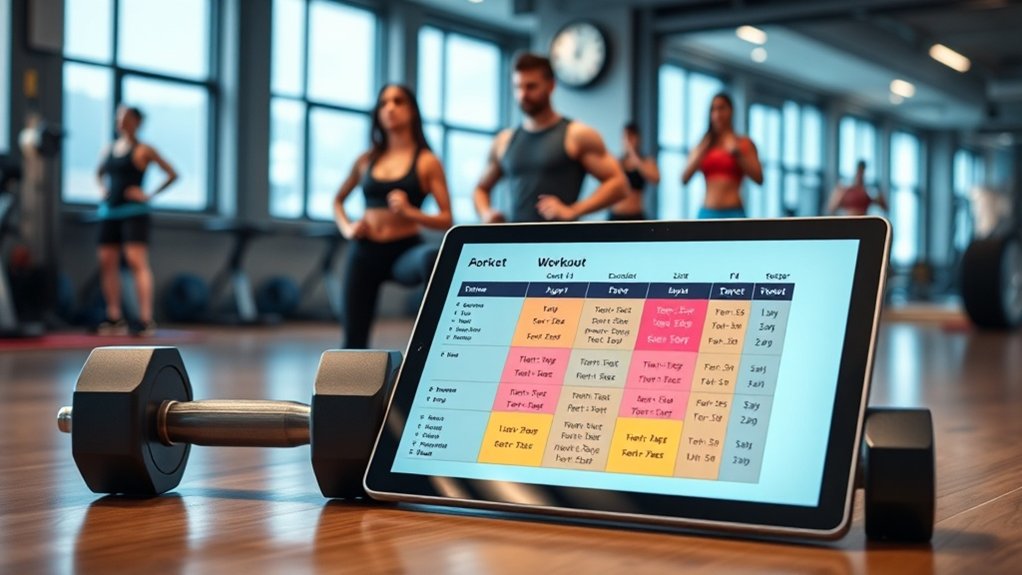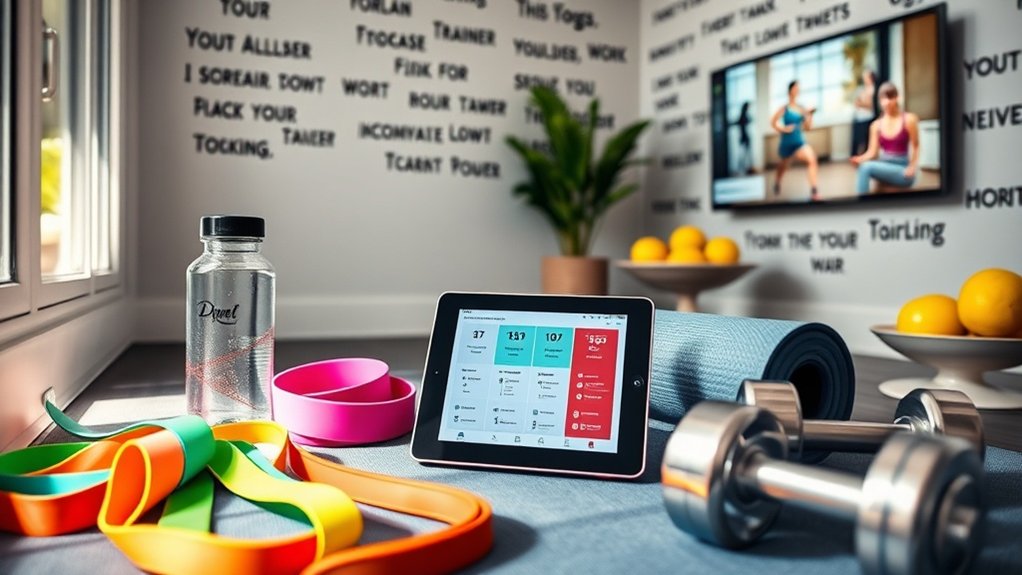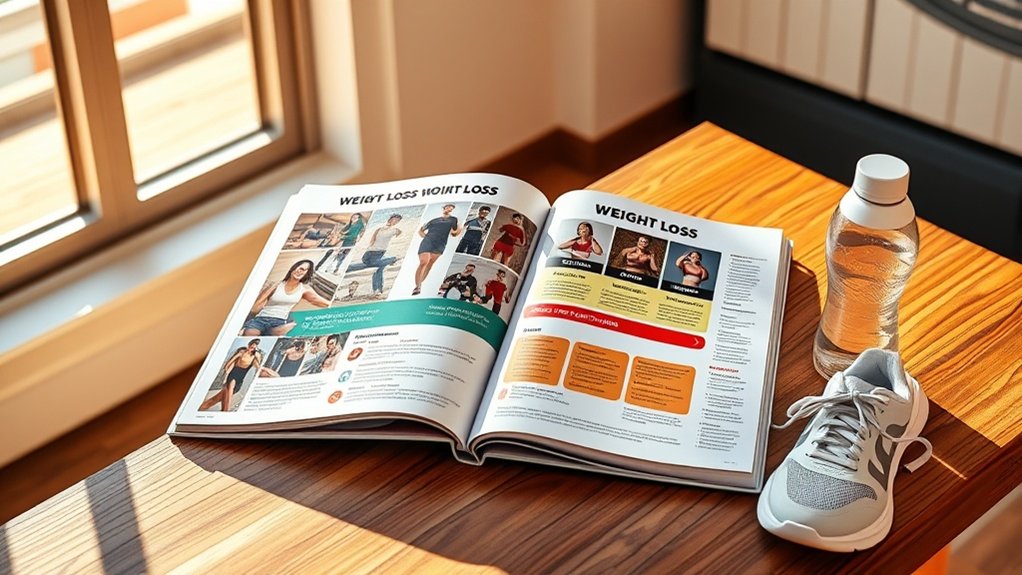Start by defining SMART fitness goals and realistically evaluating your available gym time—whether that’s 30 minutes twice weekly or an hour daily. You’ll maximize efficiency by prioritizing compound movements like squats and deadlifts that target multiple muscle groups simultaneously. Beginners should focus on 2-3 full-body sessions weekly, while advanced lifters benefit from push/pull/legs splits. Track your progress consistently, balance machines with free weights, and schedule 24-48 hours recovery between training the same muscles. The strategic approach outlined below guarantees you’ll achieve sustainable results.
Assess Your Fitness Goals and Available Gym Time

Before you step into the gym, you need to define what success looks like for your specific situation. Start by using the SMART framework to establish clear fitness goals that’ll guide your entire training plan.
Assess how much time you can realistically commit—whether it’s 30 minutes twice weekly or an hour daily—and build your workout routine around that schedule.
Set realistic expectations for your fitness journey: aim for 0.5-1% body weight loss weekly or 0.25-0.5% muscle gain.
Beginners typically thrive with 2-3 full-body sessions per week, while advanced exercisers may need 4-6 sessions. The key to progress isn’t perfection—it’s consistency.
Choose a schedule you’ll actually maintain, because your best training plan is the one you’ll follow long-term.
Strategic Exercise Selection for Maximum Efficiency
When you’re working with limited gym time, compound movements like squats, deadlifts, and bench presses should form your workout foundation because they recruit multiple muscle groups simultaneously.
Research shows these exercises produce greater hormonal responses and burn more calories than isolation movements, making them essential for efficient muscle development.
You’ll maximize your results by selecting exercises that directly align with your specific goals—whether that’s building strength, increasing muscle mass, or improving overall fitness.
Compound Movements Target Multiple Muscles
Although isolation exercises have their place, compound movements form the foundation of an efficient workout plan by recruiting multiple muscle groups in a single exercise.
When you perform squats, deadlifts, bench presses, and rows, you’ll maximize efficiency by engaging several muscles simultaneously, reducing your overall workout time while promoting thorough strength training gains.
These compound exercises deliver superior results for both building muscle and burning calories. Research shows they trigger greater hormonal responses—increasing testosterone and growth hormone levels essential for muscle development.
You’ll also experience raised metabolic rates post-workout, supporting fat loss goals.
For ideal full-body workout results, include one compound movement targeting each major muscle group: quads, hamstrings, push, and pull patterns.
This approach improves gym strength and functional performance, increasing your capability in daily activities and athletic pursuits while maintaining workout safety.
Match Exercises to Goals
Your specific fitness goals should directly dictate which exercises you’ll prioritize and how you’ll structure your training parameters. A customized workout plan requires matching compound movements to your objectives, whether you’re aiming to build muscle or lose weight. Your training programs should incorporate strategic reps and sets that align with your goals across 3-4 workouts per week.
| Goal | Reps & Sets | Rest Time |
|---|---|---|
| Muscle Building | 3-5 sets of 8-12 reps | 1-2 minutes |
| Weight Loss | 3-4 sets of 8-15 reps | 30-90 seconds |
| Strength | 4-6 sets of 3-6 reps | 2-3 minutes |
Your workout program should include one exercise from each category: quads, hamstrings, push, and pull. This guarantees thorough body workouts while maximizing efficiency through compound movements that engage multiple muscle groups simultaneously.
Building Your Custom Gym Workout Split

Your workout split determines how you’ll organize training sessions throughout the week, directly impacting your muscle growth and recovery.
Selecting the right split—whether it’s push-pull-legs, upper-lower, or full-body—depends on how many days you can consistently train and your recovery capacity.
Strategic scheduling of rest days guarantees each muscle group receives adequate recovery time while maintaining the frequency needed for peak strength and hypertrophy gains.
Choosing Your Training Split
Since your training split determines how you’ll organize workouts throughout the week, it’s one of the most critical decisions you’ll make when designing a custom program.
If you’re new to the gym regularly, start with full-body training 2-3 times weekly, allowing adequate recovery between sessions while targeting major muscle groups. As you build muscle and strength, consider shifting to an upper/lower split or the popular push/pull/legs method, assuring each muscle group receives attention twice weekly.
Advanced lifters often benefit from running PPL twice per week for increased training frequency. Your ideal workout split depends on your available days, recovery needs, and specific goals.
Choose a fitness plan that balances intensity with rest, promoting sustainable progress and injury prevention.
Scheduling Rest and Recovery
Rest days aren’t optional add-ons to your training plan—they’re when your muscles actually grow stronger. Schedule 24–48 hours of recovery between training the same muscle groups.
Your workout split should prevent consecutive targeting—that’s why push, pull, and legs splits work effectively.
Active recovery days with light walking or yoga improve your progress without interfering with muscle repair. Listening to your body matters more than rigid schedules. If you’re experiencing unusual fatigue, add extra rest to prevent overtraining and injury.
Your performance indicators tell you what’s working. Track how you feel during workouts and adjust accordingly.
Recovery needs change based on training intensity, sleep quality, and life stress. Reassess your schedule regularly—what worked last month might need modification now for continued results.
Mastering Supersets and Circuit Training at the Gym
When time constraints threaten to derail your fitness goals, supersets and circuit training offer evidence-based solutions that’ll transform your gym sessions. Supersets pair two exercises back-to-back targeting different muscle groups, while circuit training sequences multiple exercises consecutively.
Both methods dramatically improve workout efficiency by reducing workout duration without sacrificing training volume. You’ll maintain intensity through these approaches while achieving both muscle building and fat loss objectives.
Structure your routines with 2-5 sets per exercise, performing 8-15 reps to optimize results. Circuit training benefits from 1-2 minute rest periods between sets, assuring adequate recovery for sustained performance.
These time-efficient strategies raise your heart rate throughout training, delivering cardiovascular benefits alongside strength gains. You’ll maximize workout time while maintaining the intensity necessary for meaningful progress.
Compound Movements vs. Isolation Exercises: What to Prioritize

Beyond optimizing your workout timing and structure, the exercises you select determine your training outcomes. When building muscle and pursuing strength gains, compound movements should anchor your workout routine. These multi-joint exercises engage several muscle groups simultaneously, maximizing calorie burning and functional fitness benefits your workout planner should prioritize.
| Compound Movements | Isolation Exercises |
|---|---|
| Squats, deadlifts, rows | Bicep curls, leg extensions |
| Multiple muscle groups | Single muscle focus |
| Higher calorie expenditure | Lower energy demand |
| Improves functional fitness | Targets specific weaknesses |
Research confirms compound exercises deliver superior results for overall fitness and strength development. You’ll build muscle more efficiently while improving real-world movement patterns. However, don’t eliminate isolation exercises entirely—they’re valuable for addressing muscle imbalances and refining specific areas within your extensive workout routine.
Directing Equipment During Peak Hours: Smart Rotation Strategies
While selecting the right exercises forms your workout foundation, executing them efficiently during crowded gym hours requires strategic planning.
You’ll maximize efficiency by prioritizing compound exercises that target multiple muscle groups simultaneously, reducing equipment dependency.
Implement circuit training by rotating between strength machines, free weights, and alternative equipment like kettlebells or resistance bands—these often have shorter wait times.
Plan your workouts using a fitness app to create a clear station-to-station strategy before arriving at the gym.
Schedule sessions during off-peak hours when possible, typically early mornings or late evenings. This approach keeps your heart rate raised while minimizing downtime between sets.
Tracking Your Progress for Continuous Results

How do you know if your training strategy is actually working? Tracking your progress through a workout journal provides concrete evidence of your improvements. Record weight lifted, repetitions, and workout times for each session to measure improvements objectively. This data-driven approach will help identify strengths and weaknesses in your workout plan.
Compare current performance against previous sessions regularly—this comparison fuels motivation and reveals areas needing adjustment. Schedule a monthly check-in to assess results and modify your approach accordingly. Track metrics like one-rep max and workout duration to maintain accountability.
Celebrate personal records, no matter how small. These victories reinforce positive habits and encourage consistency.
Your journal becomes a roadmap showing exactly where you’ve been and where you’re heading.
Gym Equipment Guide: Machines vs. Free Weights
When you step into the gym, understanding the fundamental differences between machines and free weights will shape your entire training approach.
Free weights like dumbbells and barbells engage stabilizing muscles while promoting functional strength through greater range of motion, leading to improved muscle development and core stability. They’ll increase your athletic performance by mimicking real-life movements.
Machines provide guided motion that’s particularly valuable during injury recovery or when you’re targeting specific muscle groups with proper form. They’re safer as you’re learning new exercises.
Research shows combining both in your workout routine delivers ideal results—you’ll gain the isolation benefits of machines while developing the coordination and versatility that free weights offer, creating a thorough training strategy.
Essential Recovery and Rest Day Practices

Your carefully planned workout routine—whether you’re using machines, free weights, or both—will only deliver results if you prioritize recovery between training sessions.
Rest days are vital for muscle recovery, requiring 24-48 hours between intense workouts targeting identical muscle groups. This prevents overtraining and injury while supporting your fitness goals.
Incorporate active recovery like light walking or yoga to improve blood flow without additional strain. Hydration remains essential since water facilitates nutrient transport and muscle rebuilding.
Focus on protein intake through whole foods or shakes to meet daily requirements for peak muscle recovery.
Most importantly, listening to your body prevents setbacks. If you’re feeling fatigued or unwell, take extra rest days. This patience guarantees sustained progress rather than forcing workouts that compromise your health and long-term success.
Frequently Asked Questions
What Is the 3-3-3 Rule in Gym?
The 3-3-3 rule boosts your workout efficiency by performing three sets of three different exercises targeting one muscle group. This approach improves exercise variety in strength training, optimizes training frequency, and supports goal setting while maximizing your results.
What Is the 3 2 1 Rule in Gym?
You’ll perform three compound sets, two isolation sets, and one high-rep endurance set—because workout efficiency demands exercise variety. This structure supports time management, routine consistency, and injury prevention while enabling progress tracking toward your goal setting and fitness motivation.
What Is the 70/30 Rule Gym?
The 70/30 balance strategy means you’ll get 70% of your fitness results from nutrition and 30% from workouts. This evidence-based approach emphasizes nutrition impact over workout intensity ratio, requiring personal fitness assessment and goal setting for effective training techniques.
What Is the 2 2 2 Rule in the Gym?
Picture your workout as building blocks: the 2-2-2 rule means performing two sets of two exercises across two muscle groups. You’ll maximize workout duration while assuring exercise variety, training consistency, and balanced fitness progression through this efficient, personalized routine approach.



